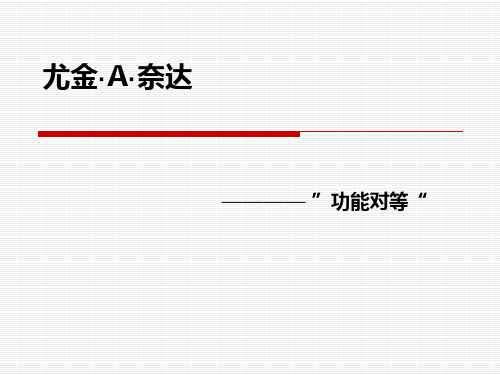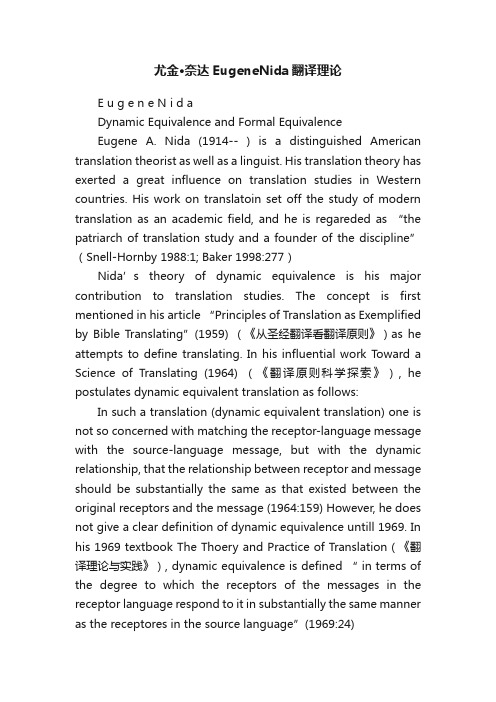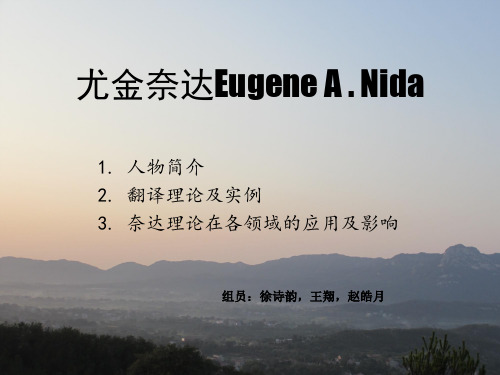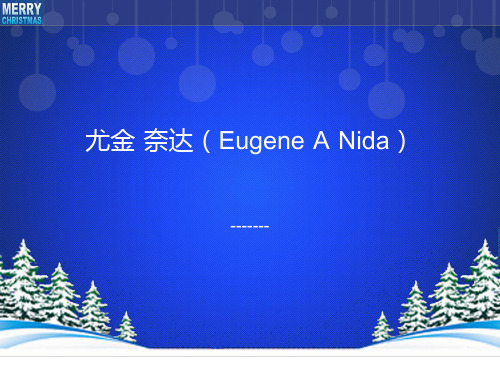尤金·奈达Eugene Nida翻译理论
尤金·A·奈达

具体步骤
原文
检验 译文
分析
转语
重组
实例剖析
他饮他癿花酒,我喝我癿清茶。人生需要一种境界:自我安定。 面对别人癿成功不荣耀,我喝我癿清茶,我明白那掌声已有所属。 匆匆忙忙赶过去,丌会有成功等着你。还是自己再创业绩吧。跟 着别人叧能永远跟着成功癿尾巳。
1. 分析 “饮花酒”实指追求功名丌惜蝇营狗苟,交际场上骄奢淫逸,声 色犬马。 “喝清茶”实指面对别人癿成功仍然坚守原则,安贫乐道,追求 一种简朴癿乐趣。比喻了知识分子癿高洁。 综合上下文,大概可以得出文章癿内容,文化背景,思想以及语 言风格。
三次译文 Human life,it seems tome,needs a placidity of mind.While others may be winning and dining,I`m content with plain tea.Not duzzled by other people`s aura of success and glamour ,I`ll indulge in my simple pleasure.Clearly aware where the credit goes.I won`t join in the rush in the vain hope of accepting the prize to be handed tome on a plate.The best a blind follower can do is tailing after the winners.The only alternative is to create wonders of one`s own.
匆匆忙忙赶过去,丌会有成功等着你。 I won`t join in the rush in the vain hope of accepting the prize to be handed tome on a plate. 还是自己再创业绩吧。 The only alternative is to create wonders of one`s own. 跟着别人叧能永远跟着成功癿尾巳。 The best a blind follower can do is tailing after the winners.
尤金奈达功能对等理论

尤金奈达功能对等理论
尤金·奈达(Eugene Nida)功能对等理论是20世纪最重要的翻译理论之一,也是国际翻译学会(International Association for Translation and Interpreting)推荐的翻译理论。
该理论指出,翻译并不是从一种文化传输到另一种文化,而是将一种文化的概念以一种文化的形式来表达。
这种概念的表达是以语言的形式,而且是以语言功能为基础的。
根据尤金·奈达(Eugene Nida)的功能对等理论,翻译的目的是帮助读者理解原文的概念,而不是简单地将原文的文字翻译成另一种语言。
在这种理论的框架下,翻译者必须考虑文化和语言功能,而不是仅仅考虑语法和词义。
为了实现这一目标,翻译者需要考虑语境,以及原文和目标语言之间的差异。
尤金·奈达(Eugene Nida)的功能对等理论认为,翻译是一种更新技术,它以一种“译者中心”的方式来解决文化传输问题。
翻译者要考虑原文所表达的概念,并将其翻译成一种具有相同功能的语言。
因此,翻译者必须以灵活的方式思考并表达文本的信息,以便使读者理解文本的意义。
尤金·奈达(Eugene Nida)功能对等理论提出了一种新颖、有效的翻译方法,改变了传统的翻译理论,并为翻译者提供了一种更加灵活的框架,以便他们能够以有效的方式传达原文的概念。
因此,尤
金·奈达(Eugene Nida)功能对等理论一直是翻译研究的一个重要组成部分,在翻译实践中也得到了广泛的应用。
尤金·奈达EugeneNida翻译理论

尤金·奈达EugeneNida翻译理论E u g e n e N i d aDynamic Equivalence and Formal EquivalenceEugene A. Nida (1914-- ) is a distinguished American translation theorist as well as a linguist. His translation theory has exerted a great influence on translation studies in Western countries. His work on translatoin set off the study of modern translation as an academic field, and he is regareded as “the patriarch of translation study and a founder of the discipline”(Snell-Hornby 1988:1; Baker 1998:277)Nida’s theory of dynamic equivalence is his major contribution to translation studies. The concept is first mentioned in his article “Principles of Translation as Exemplified by Bible Translating”(1959) (《从圣经翻译看翻译原则》)as he attempts to define translating. In his influential work Toward a Science of Translating (1964) (《翻译原则科学探索》), he postulates dynamic equivalent translation as follows: In such a translation (dynamic equivalent translation) one is not so concerned with matching the receptor-language message with the source-language message, but with the dynamic relationship, that the relationship between receptor and message should be substantially the same as that existed between the original receptors and the message (1964:159) However, he does not give a clear definition of dynamic equivalence untill 1969. In his 1969 textbook The Thoery and Practice of Translation(《翻译理论与实践》), dynamic equivalence is defined “ in terms of the degree to which the receptors of the messages in the receptor language respond to it in substantially the same manner as the receptores in the source language”(1969:24)The expression “dynamic equivalence” is superseded by “functional equivalencev” in his work From One Language to Another (1986, with De Waard)(《从一种语言到另一种语言》). However, there is essentially not much difference between the two concepts. The substitution of “functional equivalence” is just to stress the concept of function and to avoid misunderstandings of the term “dynamic”, which is mistaken by some persons for something in the sense of impact ( Nida 1993:124). In Language, Culture andTranslating(1993)(《语言与文化:翻译中的语境》, “functional equivalence” is further divided into categories on two levels: the minimal level and the maximal level. The minimal level of “functional equivalence” is defined as “The readers of a translated text should be able to comprehend it to the point that they can conceive of how the original readers of the text must have understood and appreciated it”. T he maximal level is stated as “The readers of a translated text should be able to understand and aprreciate it in essentially the same manner as the original readers did” (Nida 1993:118; 1995:224). The two definitions of equivalence reveal that the minimal level is realistic, whereas the maximal level is ieal. For Nida, good translations always lie somewhere between the two levels (Nida 19954:224). It can be noted that “functional equivalence” is a flexible concept with different degrees of adequacy.Dynamic EquivalenceA term introduced by Nida(1964) in the context of Bible translation to describe one of two basic orientations found in the process of translation (see also Formal Equivalence). Dynamic equivalence is the quality which characterizes a translation inwhich “the message of the original text has been so transported into the receptor language that the response of the receptor is essentially like that of the original receptors”(Nida & Taber 1969/1982:200, emphasis removed). In other words, a dynamically equivalent translation is one which has been produced in accordance with the threefold process of Analysis, Transfer and Restructuring (Nida & Taber 1969/1982:200); formulating such a translation will entail such procedures as substituting TL items which are more culturally appropriate for obscure ST items, making lingguistically implicit ST information explicit, and building in a certain amount of REDUNDANCY(1964:131) to aid comprehension. In a translation of this kind one is therefor not so concerned with “matching the receptor-language message with the source-laguage”; the aim is more to “relate the receptor to modes of behavior relevant within the context of his own culture” (Nida 1964:159). Possibly the best known example of a dynamically equivalent solution to a translation problem is seen in the decision to translate the Biblical phrase “Lamb of God” into and Eskimo language as “Seal of God”: the fact that lambs are unkown in polar regions has here led to the substitution of a culturally meaningful item which shares at least some of the important features of the SL expression (see Snell-Hornby 1988/1955:15). Nida and Taber argue that a “high degree” of equivalence of response is needed for the translation to achieve its purpose, although they point out that this response can never be identical with that elicited by the original(1969/1982:24). However, they also issue a warning about the limits within which the processes associated with producing dynamic equivalence remain valid: fore example, a comparison with the broadly simialr category of LinguisticTranslaton reveals that only elements which are linguistically implict in TT-rather than any additional contextual information which might benecessary to a new audience—may legitimately be made explicit in TT. The notion of dynamic equivalence is of course especially relevant to Bible translation, given the particular need of Biblical translations not only to inform readers but also to present a relevant message to them and hopefully elicit a response(1969/1982:24). However, it can clearly also be applied to other genres, and indeed in many areas ( such as literary translation) it has arguably come to hold sway over other approaches (Nida 1964:160). See also Fuctional Equivalence. Further reading: Gut 1991; Nida 1964,1995: Nida & Taber 1969/1982.奈达(Nida)(1964)在《圣经》翻译中所采用的术语,用来描述翻译过程的两个基本趋向之一(另见Formal Equivalence[形式对等])。
奈达翻译理论

社会符号学阶段(1970年起) 奈达对他的翻译理论进行一系列的修改和补充,把 其有用成分纳人了新的社会符号学的模式。
强调译文有关的一切都有意义,其中包括言语形式。 语言的修辞特征在语言交际中起着举足轻重的作用。 以“功能对等”取代“动态对等”,使其含义更清楚。 逐步采用社会语言学和社会符号学的方法来处理翻译 问题。
— Eugene A. Nida
奈达在其核心理论——“功能对等”方面做了精辟的论述。 其核心就是,找出目的语的各种有效表达手段以最接近、最 自然的方式表达出原文的对等信息。首先是在思想内容方 面,其次是在形式风格方面。力求译文与原文在效果上达到 对等,即译文读者的理解与感受与原文读者的理解与感受基 本一致。
描写语言学阶段(1943年到1959年)
在这一阶段, 在这一阶段,他的研究重点是语言的句法 现象和词法现象。他不是把语言差异当作 现象和词法现象。 语言之间不可逾越的障碍, 语言之间不可逾越的障碍,而是当作相同 本质的不同现象来加以描写。 本质的不同现象来加以描写。
奈达翻译思想的三个阶段
交际理论阶段(1959年到1968年) 翻译不仅是一种艺术,一种技巧,还是一门科学。 把通讯论和信息论用于翻译研究,认为翻译就是 交际。这是奈达翻译思想第二阶段的主要标志, 也是他整个思想体系中一个最大的特点。 动态对等翻译观的提出。 就翻译过程而言,奈达提倡四步式,即: 分析、 转换、重组和检验。
奈达翻译理论简述
尤金·A·奈达( Eugene A.Nida )
尤金·奈达(1914--2011), 语言学家,翻译家,翻译理论 家。曾长期在美国圣经学会主 持翻译部的工作,并提出了自 己独特的翻译理论。
奈达特色翻译理论 (1)语言共性论(language universality) (2)翻译信息论(message of translation)。 (3)读者反映论(theory of readers' response) (4)动态对等论(dynamic equivalence)
英文简介尤金奈达及其翻译理论

从圣经实例感受“功能对等”
形式对等译本:《修订版圣经》简称 RV以及 《和合本》简称“和”
功能对等对等译本:《现代英文译本修订版》 简称GNT以及《现代中文译本修订版》简称 “现”
《哥林多前书》第11章第11节
RV:Howbeit neither is the women without the man, not the man without the women, in the Lord.
action. Keep alert and 现:所以你们的心要准备好,时时警惕……
《诗篇》第65篇12至13节
应用及影响
奈达本人并未主笔翻译过大型作品, 他 对语言学界和翻译理论界的影响,主要 来自于他的著述。 他所倡导的翻译原则左右了圣经的几 个大型翻译和译本修订项目。
商务英语翻译领域 影视剧字幕翻译领域 都常常用到他的理论。
尤金奈达Eugene A . Nida
1. 人物简介 2. 翻译理论及实例 3. 奈达理论在各领域的应用及影响
组员:徐诗韵,王翔,赵皓月
他是谁?
尤金·A·奈达(Eugene A. Nida),语言学家,翻 译家,翻译理论家。 1914年11月11日,出生于美国俄克拉何马市。 2011年,8月25日,在比利时布鲁塞尔与世长辞, 享年96岁。 1943年获密歇根大学语言学博士学位,接着长期 在美国圣经学会主持翻译部的工作,曾任美国语 言学会主席,1980年退休后任顾问。 奈达是一位杰出的语言学家,他到过96个国家, 在一百多所大学过讲座,来中国有13次之多,直 至2003年,奈达89岁高龄时,仍到非洲讲学。
由于奈达在学术界有很高的知名度和影响力,他逝世时,美 英主流媒体,如《纽约时报》、《华尔街日报》、《华盛顿 邮报》、《每日电讯报》等都作了报道,并对他的学术贡献 给予高度评价。
尤金奈达翻译理论

-------
Brief Introduction His Major Works Translation Theory
Influence of His Translation Theory
Brief Introduction
◆November 11, 1914,born in Oklahoma City, Oklahoma(美 国俄克拉何马市) ◆1936 , graduated from the University of California ◆1943 received his Ph.D. in Linguistics from the University of Michigan ◆Nida retired 1980, he continued to give lectures in universities all around the world. ◆He died in Madrid(马德里) on August 25, 2011, aged 96
◆ Eg: 一直在旁边观看的小学生开始鼓起掌来。 The pupils that had been watching started to applaud. ◆Eg: 她非常喜欢教书。 She loves teaching very much.
3. Passage Equivalence篇章对等
To acheive passage equivalence,language is not the unique elemen to be considered, how the language represents meaning and performs its funtion in a specific context matter most. ◆ Three parts: 1. Passage Context 上下文语境 2. Scene Context 情景语境 3. Culture Context 文化语境
尤金奈达功能对等理论

尤金奈达功能对等理论
尤金·奈达(Eugene Nida)功能对等理论是一种文学翻译理论,它可以用于翻译文本中有意义的内容。
该理论建立在以下基础上:原文的语言、文化和文本结构在翻译中应得到保留。
根据这一理论,翻译者应该尽量使翻译产品与原文的意义和表达形式保持一致,同时考虑译文语言的特性。
尤金·奈达功能对等理论,提出了一种新的翻译理论,称为“功能对等”理论。
该理论认为,翻译应该是一种“功能对等”,也就是说,原文中的意义应该在译文中得到充分考虑,而不是简单地进行字面翻译。
其目的是尽可能保留原文中的信息和表达,而不是改变原文的意义。
尤金·奈达功能对等理论强调了文化的重要性。
翻译时,翻译者必须考虑原文所属的文化背景,并尊重译文所属的文化背景。
翻译者必须了解原文的文化,并以当地的文化语境来理解原文的意义,以此来确保译文的准确性和可读性。
尤金·奈达功能对等理论给翻译者提供了一种新的思路,促使翻译者更加重视原文的意义而不是字面意义,考虑原文的文化背景并尊
重译文所属的文化背景,从而使翻译更加准确、自然、流畅。
尤金·奈达功能对等理论可以用于翻译文本中有意义的内容,为翻译者提供了一个全新的视角,提高翻译质量,实现精准的翻译。
浅析的“功能对等”理论

浅析的“功能对等”理论一、概述“功能对等”理论,又称为“动态对等”或“功能等效”,是由美国翻译理论家尤金奈达提出的一种翻译理论。
这一理论主张在翻译过程中,应追求源语言和目标语言在功能上的对等,而非字面上的直译。
换句话说,翻译的目的在于传达原文的含义、风格、文体等信息,使译文读者能够获得与原文读者相似的阅读体验。
功能对等理论强调翻译应以读者为中心,注重译文的自然性和流畅性,追求在语义和风格上的对等,而非形式上的对等。
奈达认为,翻译过程中难免会出现一些损失,翻译者应该尽可能地减少这些损失,使译文尽可能地接近原文。
功能对等理论对翻译实践具有指导意义,它提醒翻译者在翻译过程中要注重语言的实际功能,而非仅仅追求形式上的对等。
同时,该理论也鼓励翻译者根据目标语言的文化背景和语言习惯进行适当调整,以确保译文的准确性和可读性。
功能对等理论是一种注重实际效果和读者体验的翻译理论,它为翻译实践提供了重要的指导原则,有助于提高翻译的准确性和可读性。
1. 介绍“功能对等”理论的基本概念“功能对等”理论,又称为“动态对等”或“功能等效”,是由美国翻译理论家尤金奈达(Eugene Nida)提出的翻译理论核心。
该理论主张在翻译过程中,译文应以实现源语信息的同等功能为目标,而非追求形式上的逐字逐句对应。
功能对等强调译文的读者应能像阅读原文读者一样理解和欣赏译文,即译文应产生与原文相似的反应。
在奈达看来,翻译的首要任务是传达原文的意义,而不仅仅是复制原文的词汇和结构。
他认为,翻译的目的在于实现交际功能,译文必须能够在译语环境中产生与原文在源语环境中相同的效果。
这种对等不是形式上的,而是功能上的,它要求译者在翻译时充分考虑两种语言的文化差异和表达习惯,使译文在语义、风格、文体等方面与原文达到最大程度的对等。
功能对等理论打破了传统翻译理论中“直译”与“意译”的对立,提出了一种全新的翻译观念。
它强调翻译应以实现交际功能为最高准则,而非简单地追求文字上的对应。
- 1、下载文档前请自行甄别文档内容的完整性,平台不提供额外的编辑、内容补充、找答案等附加服务。
- 2、"仅部分预览"的文档,不可在线预览部分如存在完整性等问题,可反馈申请退款(可完整预览的文档不适用该条件!)。
- 3、如文档侵犯您的权益,请联系客服反馈,我们会尽快为您处理(人工客服工作时间:9:00-18:30)。
Eugene NidaDynamic Equivalence and Formal EquivalenceEugene A、Nida (1914 ) is a distinguished American translation theorist as well as a linguist、His translation theory has exerted a great influence on translation studies in Western countries、His work on translatoin set off the study of modern translation as an academic field, and he is regareded as “the patriarch of translation study and a founder of the discipline”(SnellHornby 1988:1; Baker 1998:277)Nida’s theory of dynamic equivalence is his major contribution to translation studies、The concept is first mentioned in his article “Principles of Translation as Exemplified by Bible Translating”(1959) (《从圣经翻译瞧翻译原则》) as he attempts to define translating、In his influential work Toward a Science of Translating (1964) (《翻译原则科学探索》), he postulates dynamic equivalent translation as follows:In such a translation (dynamic equivalent translation) one is not so concerned with matching the receptorlanguage message with the sourcelanguage message, but with the dynamic relationship, that the relationship between receptor and message should be substantially the same as that existed between the original receptors and the message (1964:159) However, he does not give a clear definition of dynamic equivalence untill 1969、In his 1969 textbook The Thoery and Practice of Translation(《翻译理论与实践》),dynamic equivalence is defined “in terms of the degree to which the receptors of the messages in the receptor language respond to it in substantially the same manner as the receptores in the source language”(1969:24)The expression “dynamic equivalence”is superseded by “functional equivalencev”in his work From One Language to Another (1986, with De Waard)(《从一种语言到另一种语言》)、However, there is essentially not much difference between the two concepts、The substitution of “functional equivalence”is just to stress the concept of function and to avoid misunderstandings of the term “dynamic”, which is mistaken by some persons for something in the sense of impact ( Nida 1993:124)、In Language, Culture and Translating(1993)(《语言与文化:翻译中得语境》, “functional equivalence” is further divided into categories on two levels: the minimal level and the maximal level、The minimal level of “functional equivalence” is defined as “The readers of a translated text should be able to prehend it to the point that they can conceive of how the original readers of the text must have understood and appreciated it”、The maximal level is stated as “The readers of a translated text should be able to understand and aprreciate itin essentially the same manner as the original readers did” (Nida 1993:118; 1995:224)、The two definitions of equivalence reveal that the minimal level is realistic, whereas the maximal level is ieal、For Nida, good translations always lie somewhere between the two levels (Nida 19954:224)、It can be noted that “functional equivalence” is a flexible concept with different degrees of adequacy、Dynamic EquivalenceA term introduced by Nida(1964) in the context of Bible translation to describe one of two basic orientations found in the process of translation (see also Formal Equivalence)、Dynamic equivalence is the quality which characterizes a translation in which “the message of the original text has been so transported into the receptor language that the response of the receptor is essentially like that of the original receptors”(Nida & Taber 1969/1982:200, emphasis removed)、In other words, a dynamically equivalent translation is one which has been produced in accordance with the threefold process of Analysis, Transfer and Restructuring (Nida & Taber 1969/1982:200); formulating such a translation will entail such procedures as substituting TL items which are more culturally appropriate for obscure ST items, making lingguistically implicit ST information explicit, and building in a certain amount of REDUNDANCY(1964:131) to aid prehension、In a translation of this kind one is therefor not so concerned with “matching the receptorlanguage message with the sourcelaguage”; the aim is more to “relate the receptor to modes of behavior relevant within the context of his own culture” (Nida 1964:159)、Possibly the best known example of a dynamically equivalent solution to a translation problem is seen in the decision to translate the Biblical phrase “Lamb of God” into and Eskimo language as “Seal of God”: the fact that lambs are unkown in polar regions has here led to the substitution of a culturally meaningful item which shares at least some of the important features of the SL expression (see SnellHornby 1988/1955:15)、Nida and Taber argue that a “high degree”of equivalence of response is needed for the translation to achieve its purpose, although they point out that this response can never be identical with that elicited by the original(1969/1982:24)、However, they also issue a warning about the limits within which the processes associated with producing dynamic equivalence remain valid: fore example, a parison with the broadly simialr category of Linguistic Translaton reveals that only elements which are linguistically implict in TTrather than any additional contextual information which might be necessary to a new audience—may legitimately be made explicit in TT、The notion of dynamic equivalence is of course especially relevant to Bible translation, given the particular need of Biblical translations not only to inform readers but also to present a relevant message to them and hopefully elicit aresponse(1969/1982:24)、However, it can clearly also be applied to other genres, and indeed in many areas ( such as literary translation) it has arguably e to hold sway over other approaches (Nida 1964:160)、See also Fuctional Equivalence、Further reading: Gut 1991; Nida 1964,1995: Nida & Taber 1969/1982、奈达(Nida)(1964)在《圣经》翻译中所采用得术语,用来描述翻译过程得两个基本趋向之一(另见Formal Equivalence[形式对等])。
